What is email automation?
Email automation is a time-saving marketing automation strategy that uses email marketing software to send personalized emails to a target audience based on predefined triggers or schedules. It streamlines communication, nurtures leads, provides a personal touch, and enhances customer engagement.
Why is email automation important?
Email automation is not only a trend but a priority in the world of email as it's loaded with benefits that can generate more revenue. This is why 71% of marketers have prioritized expanding automation for their email programs.
So, let's see the benefits of email automation and automated email campaigns:
1. Saves time and effort
Automating repetitive tasks, like sending welcome emails or follow-ups, frees up your time to focus on strategy and other important activities.
2. Creates a personalized experience
Automated emails can be personalized based on user behavior, helping to increase engagement and build stronger customer relationships. You can automate the email and display dynamic email content based on contact information, such as age, gender, past interactions, etc.
For example, B2B brands can show recipient product recommendations based on past content downloads. Ecommerce brands can show recommendations and promotional messages based on customer engagement and browsing history.
3. Helps scale email marketing strategy
If you have a large database, manually writing and sending individual emails will be time-consuming and energy-draining. Automation can help you scale this task by allowing you to set up triggers and send emails at a specified time with the help of email marketing software like Mailmodo.
So, you don't have to sit and do the work; the email automation tool will do it for you.
4. Improves customer retention rate
Selling to an existing customer is usually more cost-effective than acquiring a new one. With automation, you can maintain consistent communication with your customers like never before.
With the website and CRM data, you can automate the upsell and cross-sell email series to turn customers into frequent ones or free trial users into paid customers. These emails are specific and relevant to the audience and designed to improve customer experience, so they might be prompted to buy again, improving the retention rate.
We built automation around real user behavior instead of relying on fixed schedules. We've seen success by creating workflows that respond to how people actually use the product in question. The results speak for themselves: trial drop-off decreased by 28% and we saw free-to-paid conversions jump by 31%.
- Arham Khan, Founder & CEO, Pixated
Different types of email automation workflow to set up
By setting up the right workflows, you can ensure that your messages reach the right people at the right time, making your campaigns more efficient and impactful. Below is a table outlining some of the most common email automation workflows you can set up for your business:
| Email automated workflow name |
When to use |
| Welcome and onboarding email series |
- When a new user sign-up for a free trial
- When a new subscriber opt-in for your newsletter |
| Abandoned cart email flow |
- When visitors add items to the cart but leave without completing the transaction |
| Follow-up email series |
- After a demo call with potential leads or customers
- After webinars or other events
- After someone has made a purchase or downloaded any lead magnet such as an e-book or a white paper |
| Re-engagement email series |
When a customer is
- Active on email but inactive on the website (product/services)
- Inactive on email but active on the website (product/services)
- Inactive on email and on your platform |
| Automated webinar email flow |
- To promote your upcoming webinar
- To keep registrants updated about the upcoming webinar |
The flows we mentioned above are the most common ones. Besides, based on which industry you operate in and the target audience’s journey and sales pipeline you can create more flows to nurture and convert them.
Incorporating AI workflow automation can further refine these processes, helping you adapt in real time to audience behavior and preferences.
Don’t know where to start?
We got you.
We have launched a collection of email automation flows across different industries to inspire your automation workflows and give expert insights.
How to automate email marketing campaigns in Mailmodo
Automation in Mailmodo can be done in two ways: using trigger campaigns and setting up customer journeys. Let's discuss the steps to set them up.
Trigger-based email automation
- Go to the “Campaigns” tab in the Mailmodo dashboard and click “Triggers”.
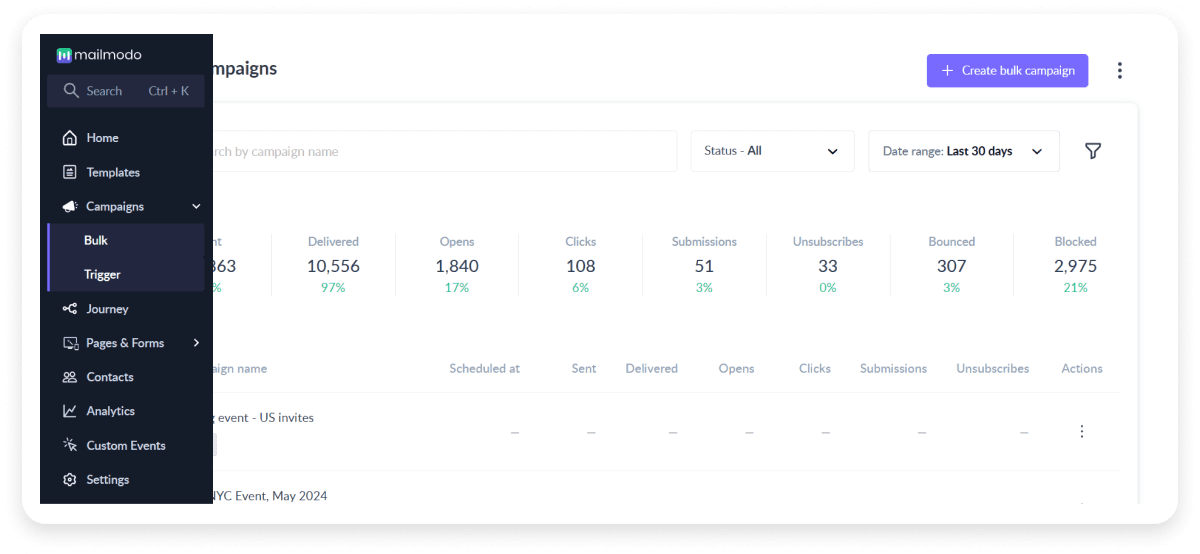
- Click “Create trigger campaign” in the upper right corner.
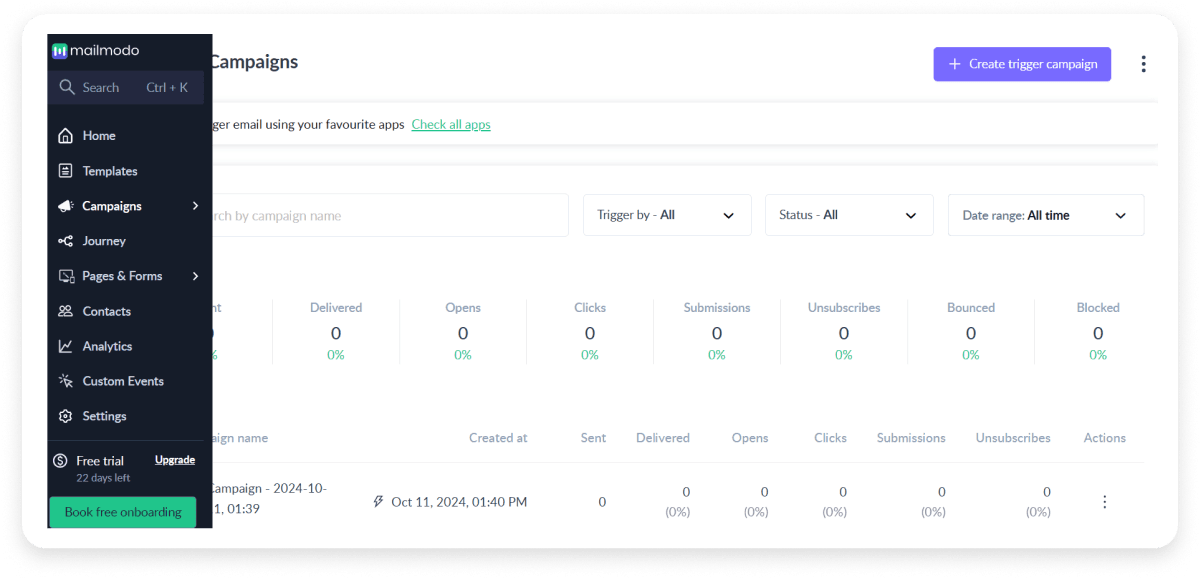
- Select from the given email templates and click on “Next”.

- Give details about your campaign, like campaign name, subject line, preheader text, etc., and click on “Next”.
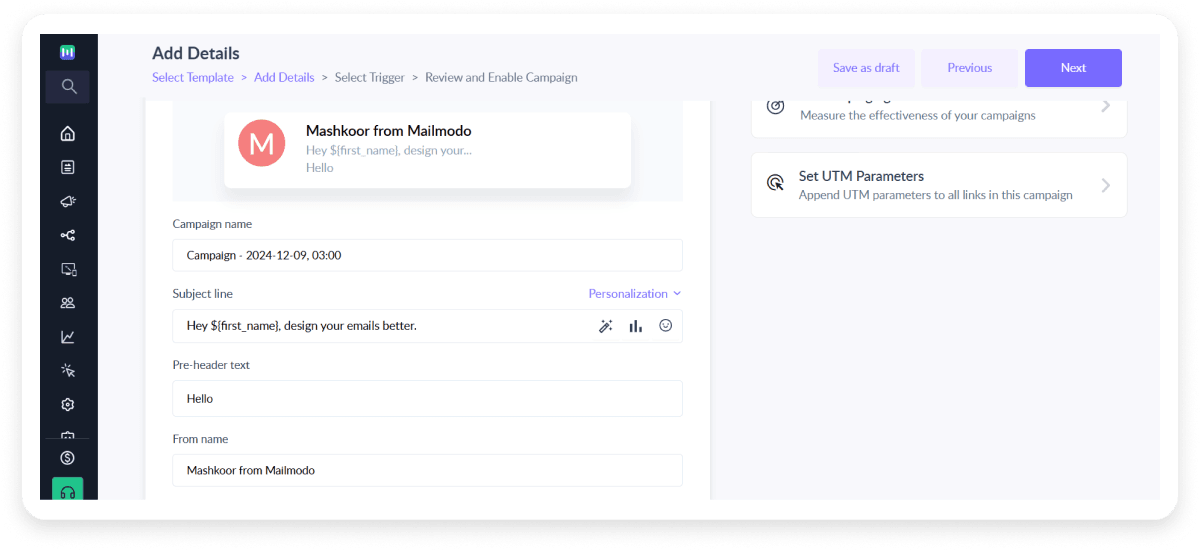
- Select the trigger relevant to your campaign from the list and click “Next”.

- Finally, review your campaign and click on “Enable campaign”.
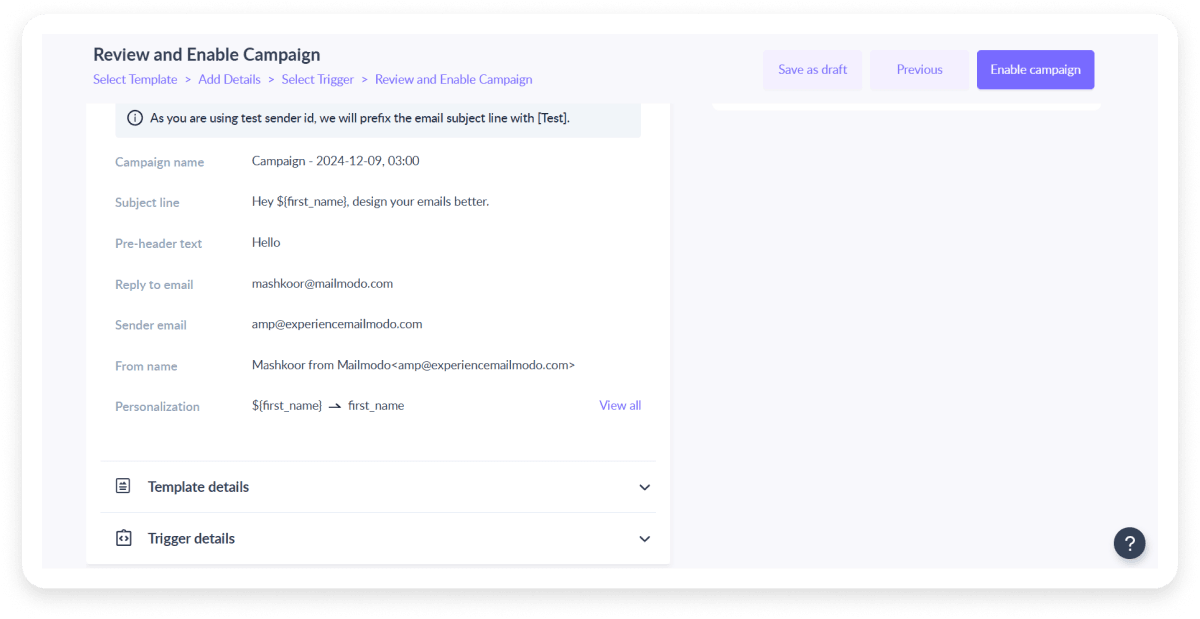
Journey-based email automation
Let's look at the steps to set up journey-based email automation.
- Go to the Mailmodo dashboard and click on “Journey”. Then, click on “Create journey” in the upper right corner.
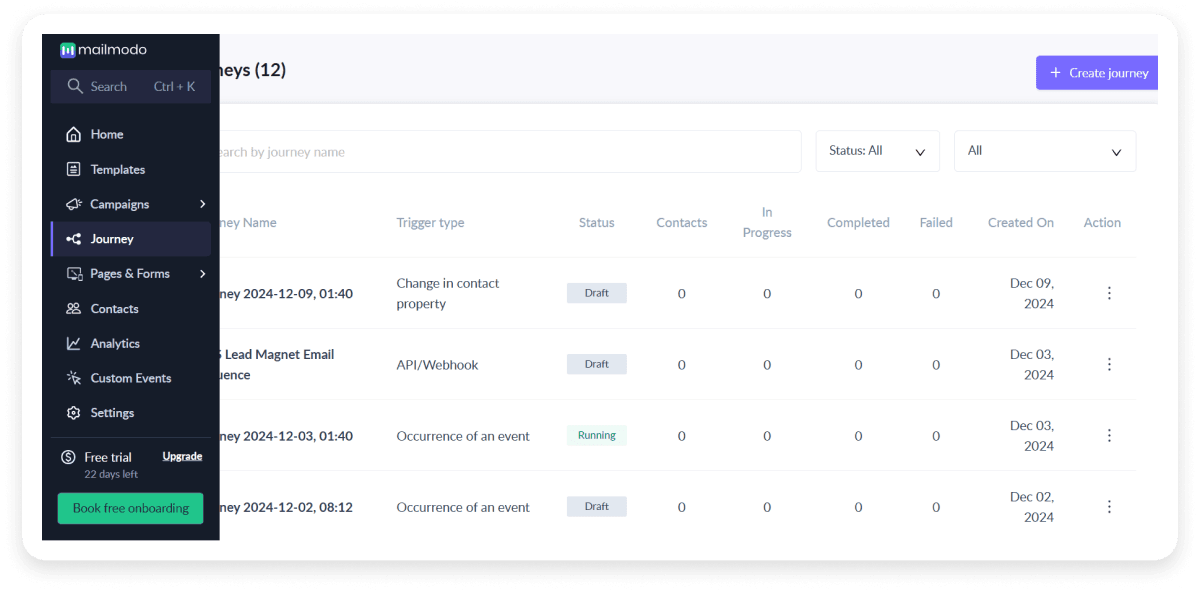
You can either choose from a prebuilt journey or start from scratch.
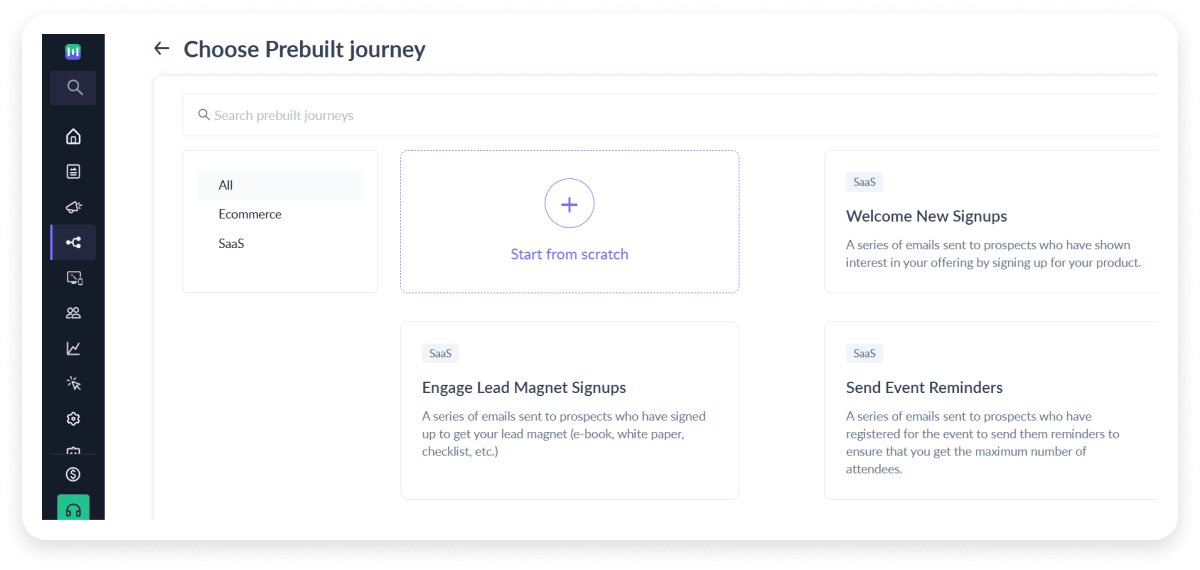
Choose the event that should trigger your email campaign, configure that trigger, and then click on "Next".
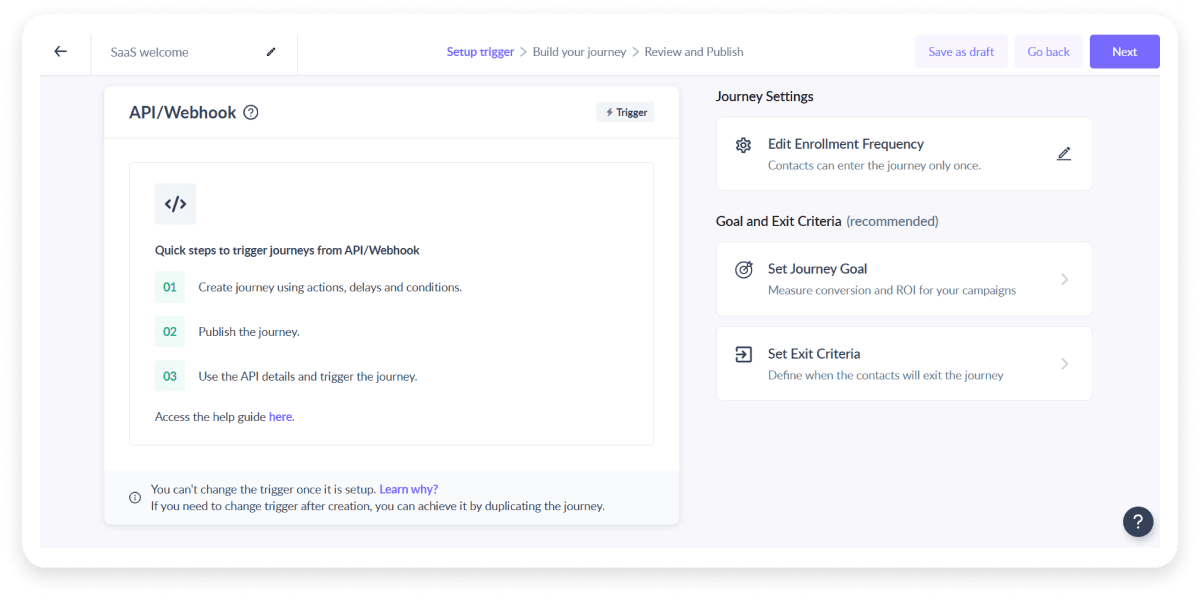
Set up the send campaign block by adding the email template you created and other relevant details like campaign name, subject line, etc.

You can similarly add other conditions or delays and more action blocks as required and then click on “Next”.
Review the details of the email sequence and edit other required details on the page.
Click on the “Publish” button to make it live.
Automate your email campaigns in minutes
Email automation example
Here, we will discuss our onboarding automated series we sent when someone signed up for Mailmodo. The basis of selection is that clients should send more than 10K emails monthly.
Email 1: Welcome new users
📩 Subject line: Welcome to Mailmodo
🕛 Sent: Right after they sign up
The first email we send is to welcome email to the new joiners and tells them about our USP - the interactive emails. We don’t just tell them but also share examples so they can see how interactive widgets work and feel within an email.
Then, we discuss the steps they must take to send their first interactive emails.
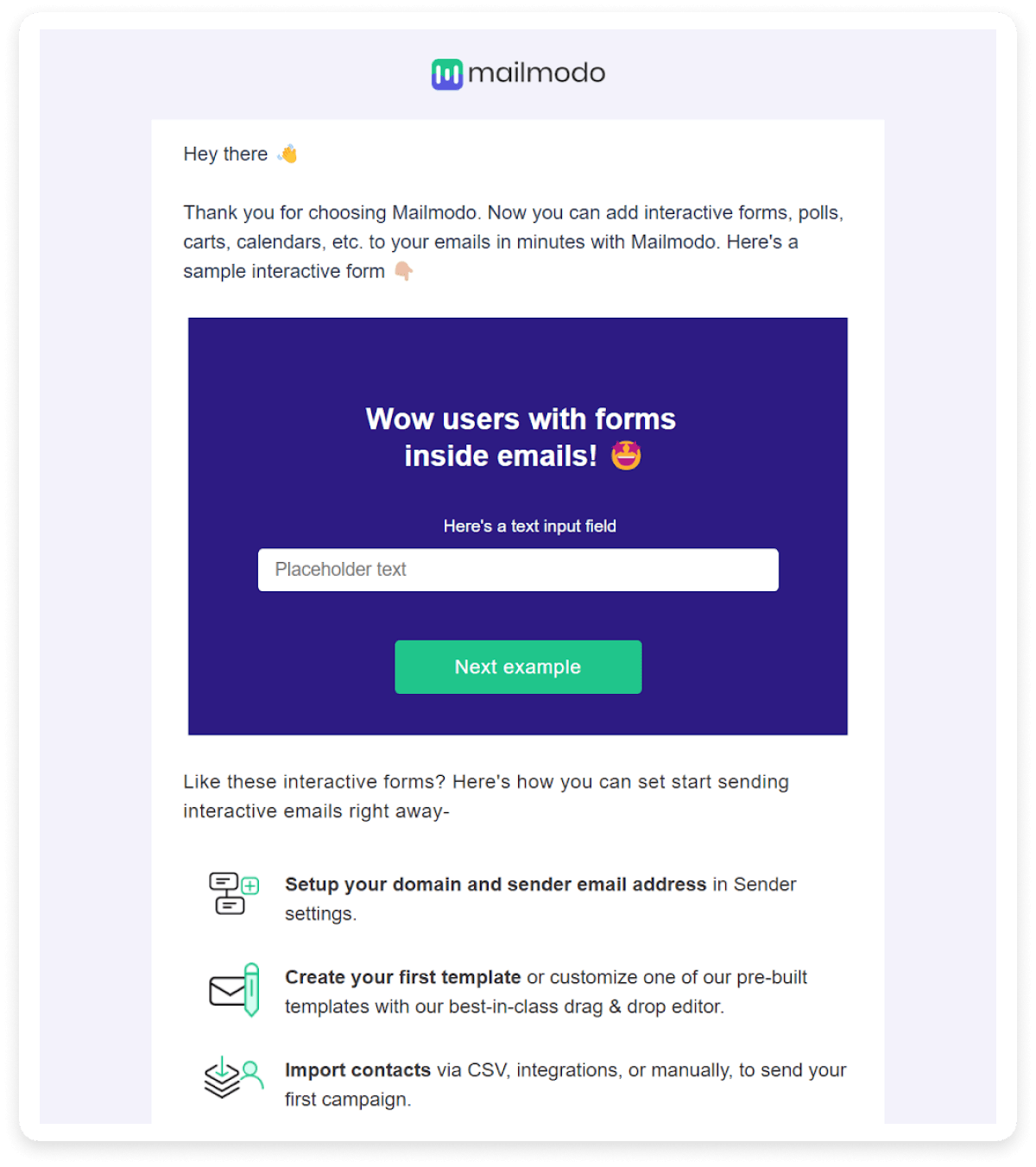
Email 2: Collect data for customer’s pain points
📩 Subject line: Let’s talk about your email marketing needs
🕛 Sent: Day 2
The main goal here is to understand the pain points of our customers. We have added interactive forms to collect their feedback. Adding a form not only showcases our product in action but also reduces friction in the submission process.
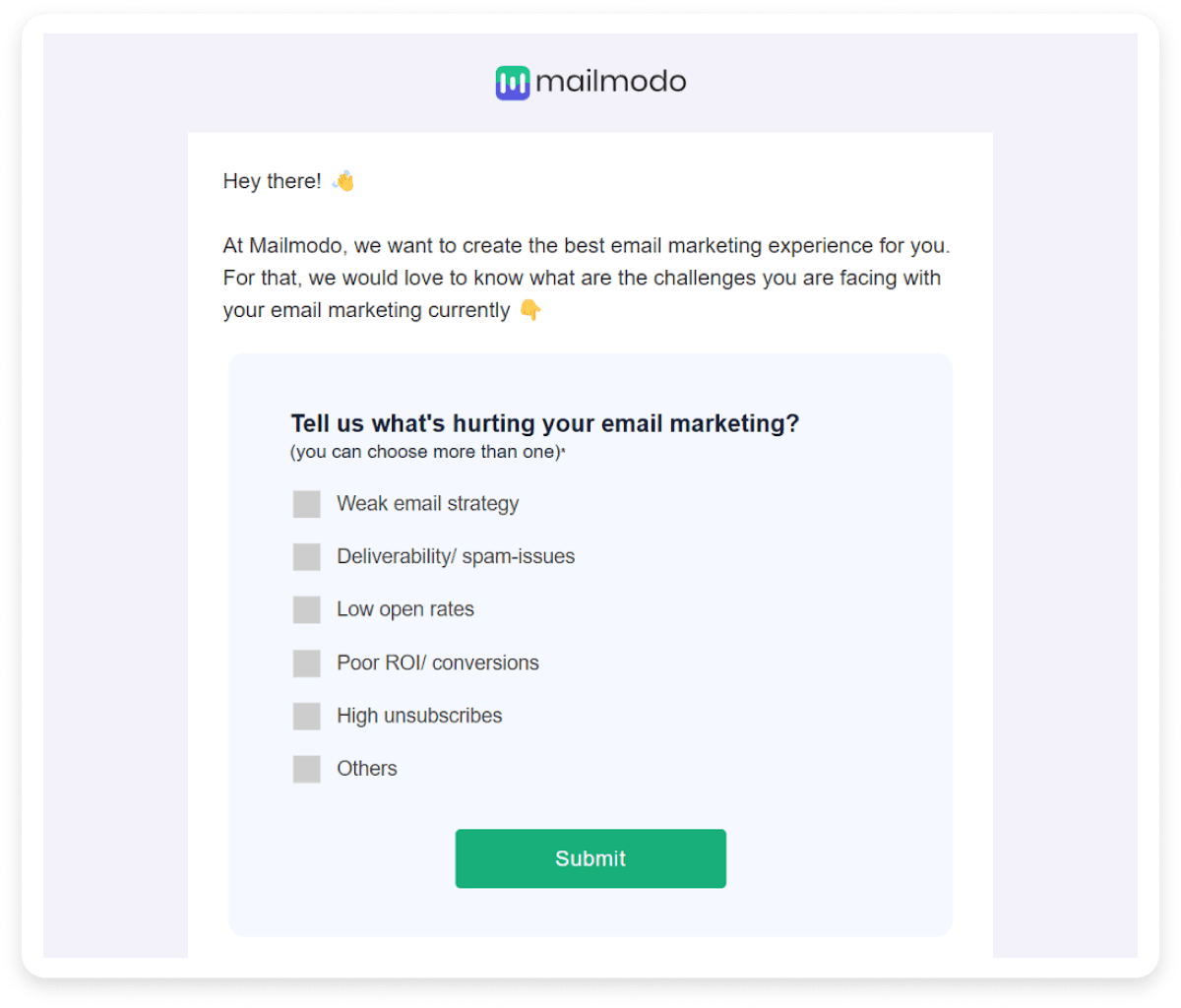
Email 3: Discuss deliverability issues
📩 Subject line: Claim your 30-min call with our deliverability expert 🎁
🕛 Sent: Day 6
Deliverability is one of the crucial factors to get right if one wants to be successful in email marketing. Given the complexity of deliverability, we often see many people struggle to get it right. That’s why our third email in the onboarding series focuses on that.
We encourage our users to book a free demo session to understand the nitty-gritty of email deliverability. Our aim in their onboarding series is to get them acquainted with the best email marketing practices instead of upselling them.
The second CTA in this email asks them to download a best practice checklist. This can be useful if the user is unwilling to book a call at this stage.
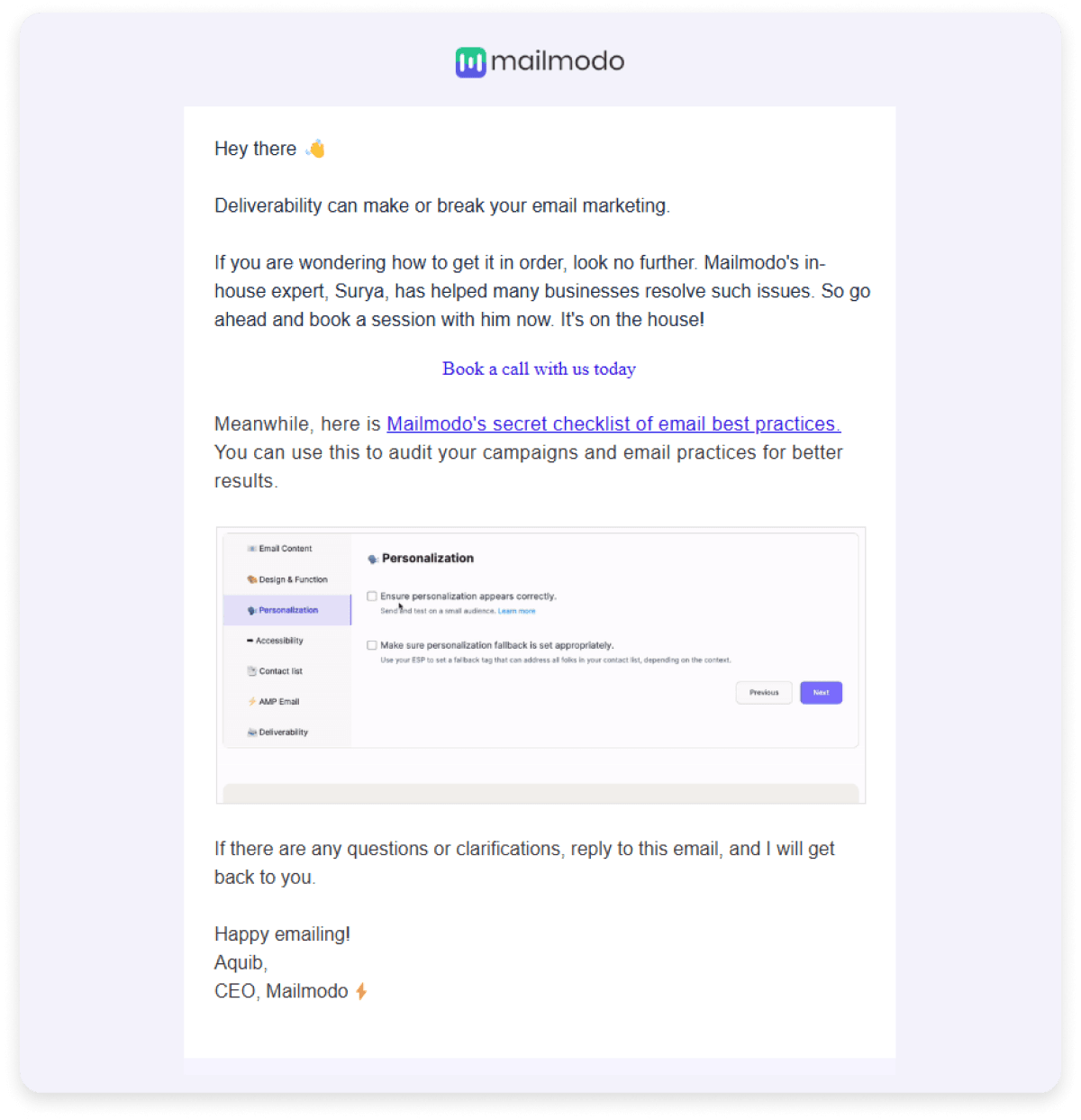
📩 Subject line: 3 features from Mailmodo to boost your email engagement 🚀
🕛 Sent: Day 10
Getting in more detail, we get users familiar with our AMP email features, mobile responsiveness, and embedded forms in the email.
We support the email copy by adding compelling visuals to let users visualize the features in real-time. We try to push them to unpack all our features and let them discover their benefits.
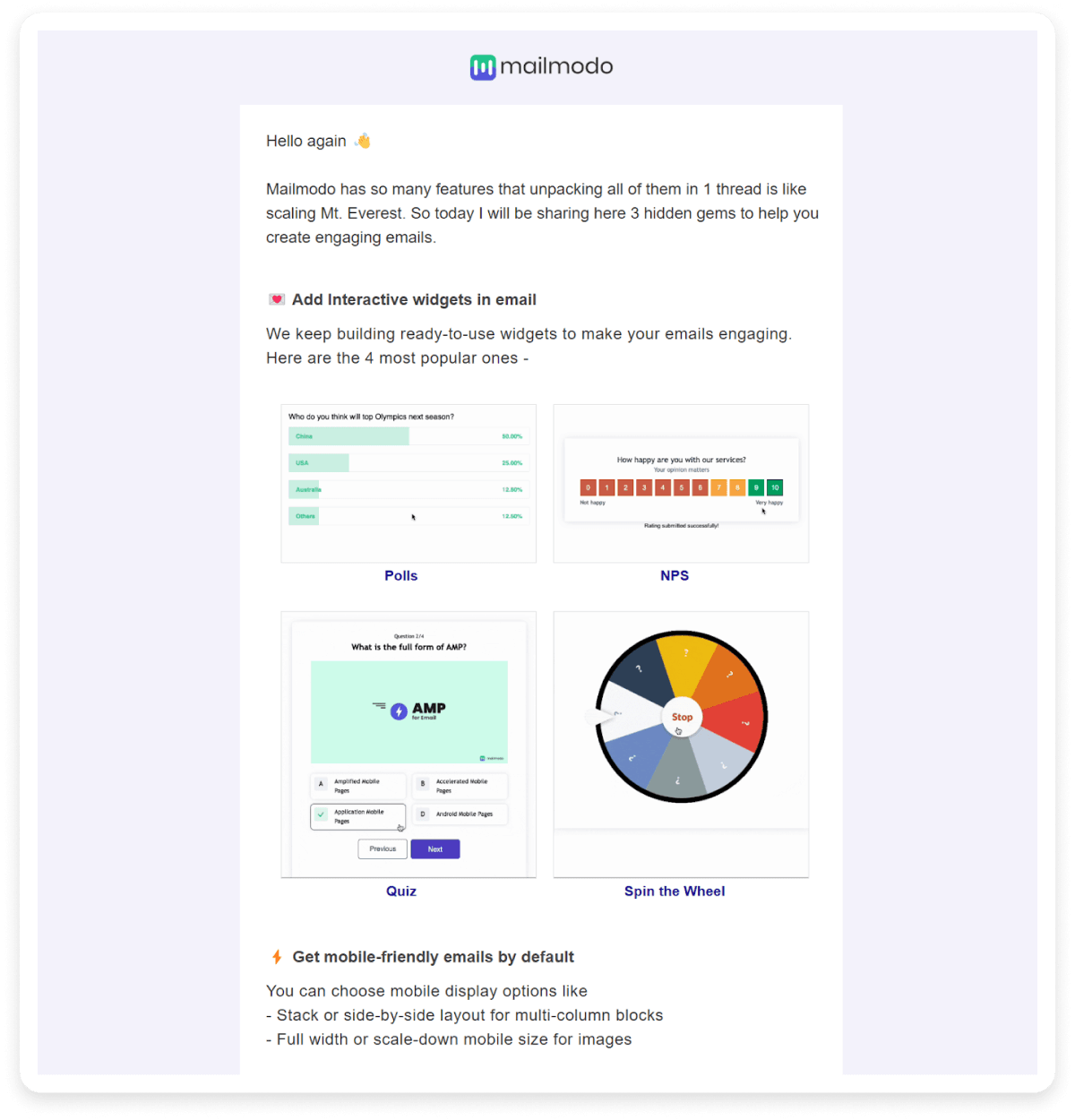
Email 5: Social proof email
📩 Subject line: How to put your "Email marketing on steroids..."
🕛 Sent: Day 12
We have already discussed our USP, collected information on their pain points, and discussed their email deliverability issues. This next email in the series is only about testimonials to strengthen our claims and build credibility.
We have curated testimonials from our clients and added them in a single email to present how well we perform and why our customers love us.
This is a way to remove any skepticism users might have about using our product.
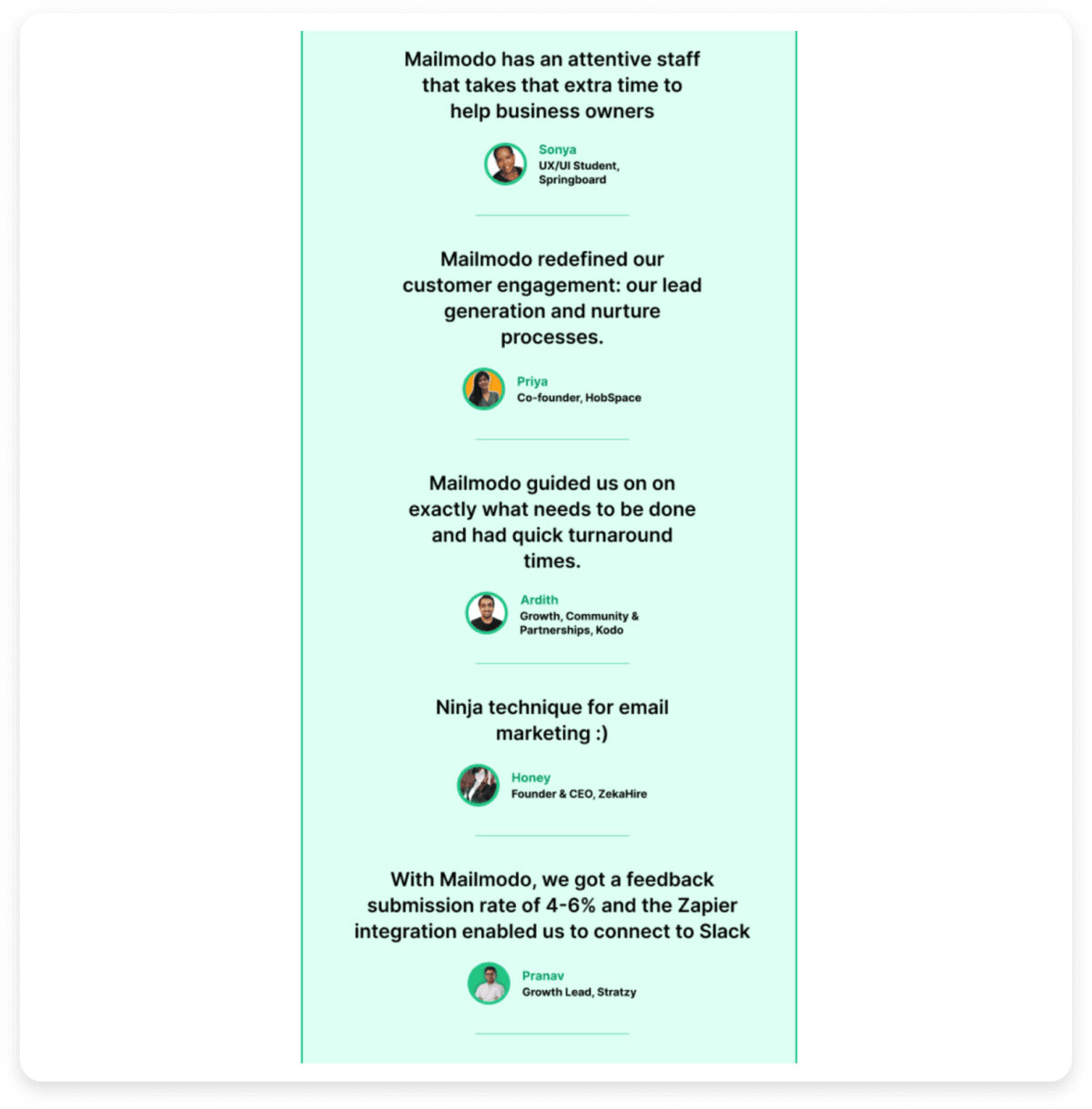
Email 6: Follow-up email
📩 Subject line: A note from Team Mailmodo 💌
🕛 Sent: Day 12. Sent after a delay of 6 hours.
It’s the last email we sent which we thanked them for being a part of our brand and asked them to book a meeting. The idea behind adding this CTA is by this point, they might have tried some of the features and have questions.
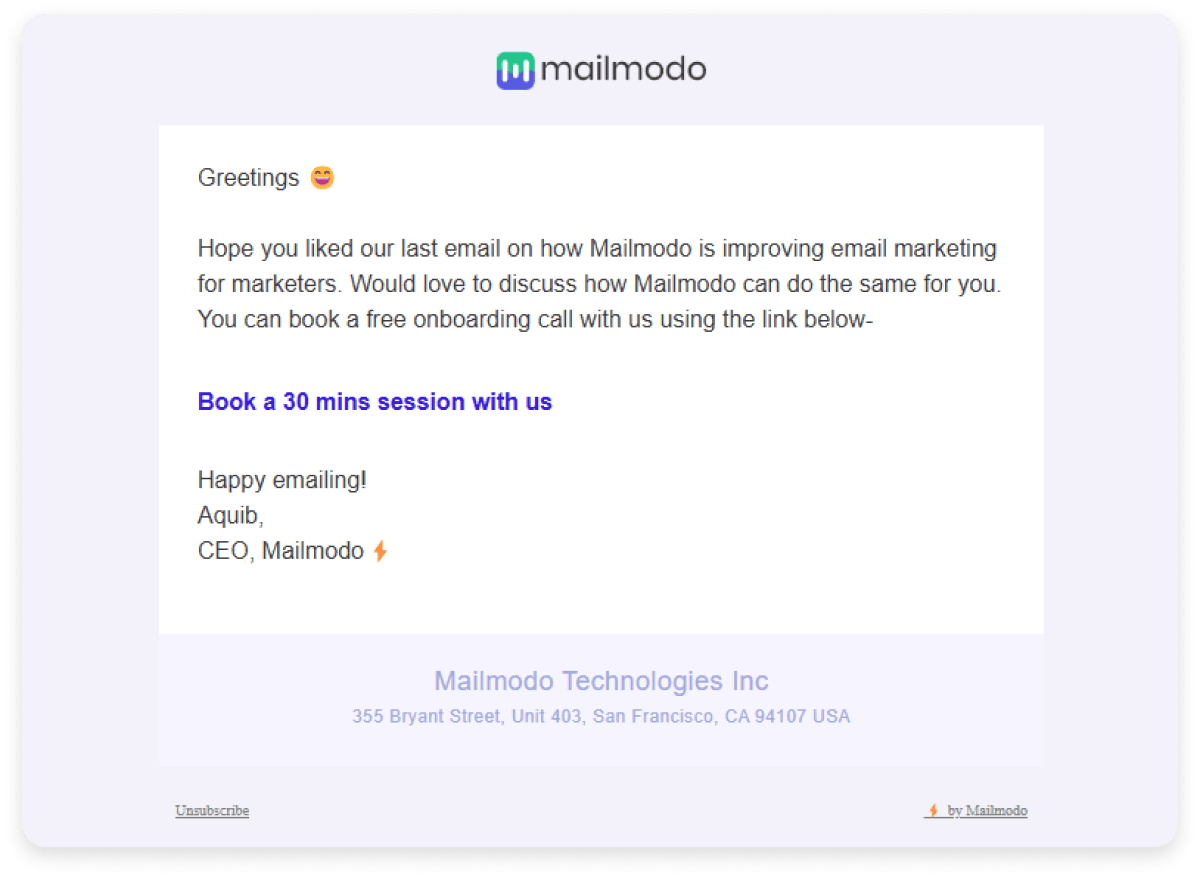
So, this was one of the automated series we sent to our customers. You can create a series in such a way using our drag-and-drop journey builder.
Tips for effective email automation
Email automation is a powerful tool for streamlining communication, improving customer engagement, and saving time. Here are some key tips for making your email automation more effective:
1. Test your automation
Test your email automation to check if it works properly and is triggered at the right time. Testing helps you to refine your email automation strategy over time.
2. Add a personal touch
Use personalization tokens (such as first names or company names) in your automated emails to make them feel more personal and tailored to the recipient. Use the data you collect on user behavior to send timely and relevant emails, such as offering discounts on items they’ve previously shown interest in.
3. Use trigger-based automation
Implement automation based on user actions or milestones, such as sign-ups, purchases, or cart abandonment. Triggered emails are highly relevant and timely, leading to higher engagement.
Track key metrics like open rates, click-through rates, conversion rates, and unsubscribe rates. This data will help you evaluate the effectiveness of your email automation campaigns and identify areas for improvement.
5. Avoid over-automation
While automation is efficient, don’t let it replace personal interactions entirely. Balance automated emails with personalized communication when necessary to keep the human touch in your brand.
Start automating your campaigns
Do not think you'll see higher clicks and engagement just because you have automated the email campaign, using the right trigger, and setting the email cadence. In the end, email automation will work only if your message is relevant to the reader. If you send them generic, unsolicited automated emails, they'll have no choice but to mark you as spam.
So, focus on sending personalized automated emails to your recipients that are valuable to them.


























